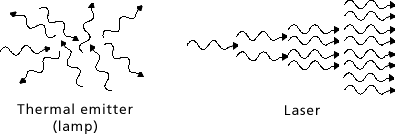Light is a form of electromagnetic radiation with wavelengths less than several hundred m m. The emission and absorption of electromagnetic radiation is caused by the acceleration of electrically charged particles. If the frequencies are sufficiently small, corresponding to large wavelengths, this occurs, for instance, via alternating current in antennas. In the visible spectrum, atoms or molecules act as these antennas which can emit or absorb light on transition between the various internal states.On absorption, a quantum (a unit of energy) of electromagnetic field is captured by an atom or molecule and the energy in the light quantum is converted into atomic excitation energy. The energy in a quantum of light is equal to the product of Planck’s constant, a natural constant, and the frequency of the light. The excited atom can re-emit this excitation energy in the form of a quantum of light, either spontaneously or through stimulation by the external radiation field. During spontaneous emission, the quantum is emitted in a random direction at a random phase. This occurs, for instance, in ordinary lamps, and the resultant radiation field consists of overlapping wave trains at various phases and in various directions. In contrast, the atoms emitted during stimulated emission are forced into phase by the radiation field. When a number of these in-phase wave trains overlap each other, the resultant radiation field propagates in the one direction with a very stable amplitude. The spectral bandwidth of the radiation is also much smaller than that
of an ordinary lamp.
Laser Principle
Two conditions must be met in order to synchronise this stimulated atomic emission: firstly, there must be more atoms present in their higher, excited states than in the lower energy levels, i.e. there must be an inversion. This is necessary otherwise the stimulated emissions of quanta will bedirectly re-absorbed by the atoms which are present in lower energy states. The inverted condition does not prevail in nature: the lower energy levels are normally more densely populatedthan the higher levels. Some means of ‘pumping’ the atoms is therefore needed.
The second important condition is that the radiation field is sufficiently large in order that there are more stimulated emissions than spontaneous ones. Some laser media are reinforced to such an extent that the radiation field is almost large enough as it is. An optical resonator must normally beused to feed the radiation field back into the medium. The two most important components in a laser are thus
- the active light-emitting medium and
- the optical resonator for regenerating the radiation field.
 Fraunhofer Institute for Laser Technology ILT
Fraunhofer Institute for Laser Technology ILT